A Joint Low-Rank and Sparse Method for Reference Signal Purification in DTMB-Based Passive Bistatic Radar
Abstract
1. Introduction
2. System Model of DTMB-Based PBR
2.1. Frame Structure of DTMB Signal
2.2. Signal Model
2.3. Radar Ambiguity Function
3. Synchronizations
3.1. Sampling Rate Synchronization
3.2. Symbol Synchronization
3.3. Carrier Synchronization
4. CIR Estimation Based on the Low-Rank and Sparse Properties
4.1. Compressed Sensing (CS) Channel Model
4.2. SVD Based on Low-Rank Property
- (1)
- Applying SVD for matrix PNcs, Equation (19) can be expressed aswhere U and V are the Lpn × Lpn right and M × M left singular matrix, respectively; is a Lpn × M diagonal matrix, where is the singular value, and 0 is the null matrix.
- (2)
- Exploiting the potential low-rank property of DTMB signal, the optimal approximation matrix of PNcs can be calculated by performing the inverse operation of SVD, which is given aswhere Co = [Io,0]T is a Lpn × M matrix, Io is a o × o unit matrix, and o is the dominant singular value number, which is set to 1 in the DTMB system.
- (3)
- Splitting the matrix PNsvd, we can obtain the noise-reduced PN sequences pnsvd-m. Consequently, the IBI-free region of pnsvd-m with length B is treated as the compressed signal, i.e., y = [pnsvd-m[Ltap−1], pnsvd-m[Ltap], …, pnsvd-m[Lpn − 1]]T.
4.3. TC-AOMP Algorithm
| Algorithm 1. Summarize: The main procedures of the TC-AOMP algorithm. | |
| 0 | Parameter specification: wk is the residual; the iteration number k; denotes the empty set; is the index set in k iterations; zk is the selected index in k iterations; is the optimal atomic set selected from the sensing matrix Θ; the iteration termination threshold ε; θ is the estimation CIR; <∙,∙> denotes the inner product operator; |
| 1 | Initialization: set the residual w0 = y; k = 1; the total iteration number K = Lpre (Lpre is preamble length of PN sequence) ; ; ; |
| 2 | Optimal sparse CIR estimation: Go through each k in [1 K]with interval 1; |
| 3 | fork = 1,⋯,K do Calculate the inner product of the sensing matrix Θ and w0, and then find the index corresponding to the maximum inner product value, which given as ; |
| 4 | Update the index set and the atomic matrix ; |
| 5 | Calculate the CIR via least squares at k iterations, as ; |
| 6 | Equalize the signal rcs-m via the estimated CIR , obtain the equalized signal req-m; |
| 7 | Perform temporal correlation of the equalized signal req-m, and then calculate its ISLR; |
| 8 | If or k > K, jump out of the loop, output the equalized signal req-m; otherwise continue iteration; |
| 9 | Update the residual ; |
| 10 | End |
5. Simulation Results
5.1. CIR Estimation Results
5.2. CIR Estimation Performance Analysis
6. Field Experimental Results
7. Conclusions
Author Contributions
Funding
Acknowledgments
Conflicts of Interest
References
- Berger, C.R.; Demissie, B.; Heckenbach, J.; Willett, P.; Zhou, S. Signal Processing for Passive Radar Using OFDM Waveforms. IEEE J. Sel. Top. Signal Process. 2010, 4, 226–238. [Google Scholar] [CrossRef]
- Malanowski, M.; Kulpa, K.; Kulpa, J.; Samczynski, P.; Misiurewicz, J. Analysis of detection range of FM-based passive radar. IET Radar Sonar Navig. 2014, 8, 153–159. [Google Scholar] [CrossRef]
- Edrich, M.; Schroeder, A.; Meyer, F. Design and performance evaluation of a mature FM/DAB/DVB-T multi-illuminator passive radar system. IET Radar Sonar Navig. 2014, 8, 114–122. [Google Scholar] [CrossRef]
- Daun, M.; Nickel, U.; Koch, W. Tracking in multistatic passive radar systems using DAB/DVB-T illumination. Signal Process. 2012, 92, 1365–1386. [Google Scholar] [CrossRef]
- Palmer, J.E.; Harms, H.A.; Searle, S.J.; Davis, L. DVB-T Passive Radar Signal Processing. IEEE Trans. Signal Process. 2013, 61, 2116–2126. [Google Scholar] [CrossRef]
- Klincewicz, K.; Samczyński, P. Method of Calculating Desynchronization of DVB-T Transmitters Working in SFN for PCL Applications. Sensors 2020, 20, 5776. [Google Scholar] [CrossRef] [PubMed]
- Zeng, H.; Chen, J.; Wang, P.; Liu, W.; Zhou, X.; Yang, W. Moving Target Detection in Multi-Static GNSS-Based Passive Radar Based on Multi-Bernoulli Filter. Remote Sens. 2020, 12, 3495. [Google Scholar] [CrossRef]
- Zheng, Y.; Zhang, Z.; Feng, L.; Zhu, P.; Zhou, F. Enhanced Passive GNSS-Based Radar Imaging Based on Coherent Integrated Multi-Satellite Signals. Sensors 2020, 20, 842. [Google Scholar] [CrossRef]
- Lü, M.; Yi, J.; Wan, X.; Zhan, W. Co-channel Interference in DTMB-Based Passive Radar. IEEE Trans. Aerosp. Electron. Syst. 2019, 55, 2138–2149. [Google Scholar] [CrossRef]
- Geng, C.; Bo, T.; Jian, G.; Cunqian, F. Passive radar channel estimation based on PN sequence of DTMB signal. In Proceedings of the IEEE 11th Sensor Array and Multichannel Signal Processing Workshop (SAM), Hangzhou, China, 8–11 June 2020; pp. 1–4. [Google Scholar]
- Song, J. Technical Review on Chinese Digital Terrestrial Television Broadcasting Standard and Measurements on Some Working Modes. IEEE Trans. Broadcasting 2007, 53, 1–7. [Google Scholar] [CrossRef]
- Chinese National Standard, GB/T 26666–2011. Implementation Guidelines for Transmission System of Digital Terrestrial Television Broadcasting; National Press and Publication Administration, 2011; Available online: http://www.gb688.cn/bzgk/gb/newGbInfo?hcno=EC0A78F24C9CDB1C83627689B1A6C5C8 (accessed on 1 June 2011). (In Chinese)
- Pignol, F.; Colone, F.; Martelli, T. Lagrange-Polynomial-Interpolation-Based Keystone Transform for a Passive Radar. IEEE Trans. Aerosp. Electron. Syst. 2017, 47, 1151–1167. [Google Scholar] [CrossRef]
- Sun, Z.; Li, X.; Yi, W.; Cu, G.; Kong, L. Detection of weak maneuvering target based on keystone transform and matched filtering process. Signal Process. 2017, 140, 127–138. [Google Scholar] [CrossRef]
- Gang, C.; Jun, W.; Luo, Z.; Dawei, Z.; Yuanyuan, W. Two-stage clutter and interference cancellation method in passive bistatic radar. IET Signal Process. 2020, 14, 342–351. [Google Scholar] [CrossRef]
- Colone, F.; Palmarini, C.; Martelli, T.; Tilli, E. Sliding extensive cancellation algorithm for disturbance removal in passive radar. IEEE Trans. Aerosp. Electron. Syst. 2016, 52, 1309–1326. [Google Scholar] [CrossRef]
- Bolvardi, H.; Derakhtian, M.; Sheikhi, A. Dynamic Clutter Suppression and Multitarget Detection in a DVB-T-Based Passive Radar. IEEE Trans. Aerosp. Electron. Syst. 2017, 53, 1812–1825. [Google Scholar] [CrossRef]
- Cui, G.; Liu, J.; Li, H.; Himed, B. Signal detection with noisy reference for passive sensing. Signal Process. 2015, 108, 389–399. [Google Scholar] [CrossRef]
- Cao, W.; Li, X.; Hu, W.; Lei, J.; Zhang, W. OFDM reference signal reconstruction exploiting subcarrier-grouping-based multi-level Lloyd-Max algorithm in passive radar systems. IET Radar Sonar Navig. 2017, 11, 873–879. [Google Scholar] [CrossRef]
- Baczyk, M.K.; Malanowski, M. Reconstruction of the reference signal in DVB-T-based passive radar. Int. J. Electron. Telecommun. 2011, 57, 43–48. [Google Scholar] [CrossRef]
- Zuo, L.; Wang, J.; Wang, J.; Chen, G. UAV detection via long-time coherent integration for passive bistatic radar. Digit. Signal Process. 2021, 112, 102997. [Google Scholar] [CrossRef]
- Baczyk, M.K.; Malanowski, M. Decoding and reconstruction of reference DVB-T signal in passive radar systems. In Proceedings of the 11th International Radar Symposium, Vilnius, Lithuania, 16–18 June 2010; pp. 1–4. [Google Scholar]
- Wan, X.; Wang, J.; Hong, S.; Tang, H. Reconstruction of reference signal for DTMB-based passive radar systems. In Proceedings of the IEEE CIE International Conference on Radar, Chengdu, China, 24–27 October 2011; pp. 165–168. [Google Scholar]
- Yang, F.; Wang, J.; Song, J.; Yang, Z. Novel channel estimation method based on PN sequence reconstruction for Chinese DTTB system. IEEE Trans. Consum. Electron. 2008, 54, 1583–1589. [Google Scholar] [CrossRef]
- Van de Beek, J.-J.; Edfors, O.; Sandell, M.; Wilson, S.K.; Borjesson, P.O. On channel estimation in OFDM systems. In Proceedings of the IEEE 45th Vehicular Technology Conference, Countdown to the Wireless Twenty-First Century, Chicago, IL, USA, 25–28 July 1995; pp. 815–819. [Google Scholar]
- Liu, J.; Mei, K.; Zhang, X.; Ma, D.; Wei, J. Online Extreme Learning Machine-Based Channel Estimation and Equalization for OFDM Systems. IEEE Commun. Lett. 2019, 23, 1276–1279. [Google Scholar] [CrossRef]
- Qiao, Y.; Yu, S.; Su, P.; Zhang, L. Research on an iterative algorithm of LS channel estimation in MIMO OFDM systems. IEEE Trans. Broadcasting 2005, 51, 149–153. [Google Scholar] [CrossRef]
- Berger, C.R.; Wang, Z.; Huang, J.; Zhou, S. Application of compressive sensing to sparse channel estimation. IEEE Commun. Mag. 2010, 48, 164–174. [Google Scholar] [CrossRef]
- Ding, W.; Yang, F.; Pan, C.; Dai, L.; Song, J. Compressive Sensing Based Channel Estimation for OFDM Systems under Long Delay Channels. IEEE Trans. Broadcasting 2014, 60, 313–321. [Google Scholar] [CrossRef]
- Chinese National Standard, GB 20600–2006. Framing Structure, Channel Coding and Modulation for Digital Television Terrestrial Broadcasting System; National Press and Publication Administration, 2006; Available online: http://www.gb688.cn/bzgk/gb/newGbInfo?hcno=41F48525779777A75F0898B87E9BD24E (accessed on 1 August 2006). (In Chinese)
- Dai, L.; Wang, Z.; Yang, Z. Time-frequency training OFDM with high spectral efficiency and reliable performance in high speed environments. IEEE J. Sel. Areas Commun. 2012, 30, 695–707. [Google Scholar] [CrossRef]
- Gao, Z.; Dai, L.; Shen, W.; Wang, Z. Temporal correlation based sparse channel estimation for TDS-OFDM in high-speed scenarios. In Proceedings of the IEEE Military Communications Conference, Tampa, FL, USA, 26–28 October 2015; pp. 798–803. [Google Scholar]
- He, Y.; Zhang, C.; Tang, X.; Chu, X. Coherent integration loss due to pulses loss and phase modulation in passive bistatic radar. Digit. Signal Process. 2013, 23, 1265–1276. [Google Scholar] [CrossRef]
- Saini, R.; Cherniakov, M. DTV signal ambiguity function analysis for radar application. IEE Proc. Radar Sonar Navig. 2005, 152, 133–142. [Google Scholar] [CrossRef]
- Schüpbach, C.; Patry, C.; Maasdorp, F.; Böniger, U. Micro-UAV detection using DAB-based passive radar. In Proceedings of the IEEE Radar Conference (RadarConf), Seattle, WA, USA, 8–12 May 2017; pp. 1037–1040. [Google Scholar]
- Proakis, J.G.; Manolakis, D.G. Digital Signal Processing; PHI Publication: New Delhi, India, 2004. [Google Scholar]
- Bajwa, W.U.; Haupt, J.; Sayeed, A.M.; Nowak, R. Compressed Channel Sensing: A New Approach to Estimating Sparse Multipath Channels. Proc. IEEE 2010, 98, 1058–1076. [Google Scholar] [CrossRef]
- Dai, L.; Wang, Z.; Yang, Z. Compressive Sensing Based Time Domain Synchronous OFDM Transmission for Vehicular Communications. IEEE J. Sel. Areas Commun. 2013, 31, 460–469. [Google Scholar]
- Biondi, F. Compressed sensing radar—New concepts of incoherent continuous wave transmissions. In Proceedings of the 2015 3rd International Workshop on Compressed Sensing Theory and its Applications to Radar, Sonar and Remote Sensing (CoSeRa), Pisa, Italy, 17–19 June 2015; pp. 204–208. [Google Scholar]
- Gogineni, S.; Setlur, P.; Rangaswamy, M.; Nadakuditi, R.R. Passive radar detection with noisy reference signal using measured data. In Proceedings of the IEEE Radar Conference (RadarConf), Seattle, WA, USA, 8–12 May 2017; pp. 0858–0861. [Google Scholar]
- Zhu, Z.; Xu, X. Adaptive Channel Estimation Algorithm Based on Modified Compressed Sensing. In Proceedings of the IEEE 19th International Conference on Communication Technology (ICCT), Xi’an, China, 16–19 October 2019; pp. 50–54. [Google Scholar]
- Zheng, L.; Wang, X. Super-Resolution Delay-Doppler Estimation for OFDM Passive Radar. IEEE Trans. Signal Process. 2017, 65, 2197–2210. [Google Scholar] [CrossRef]
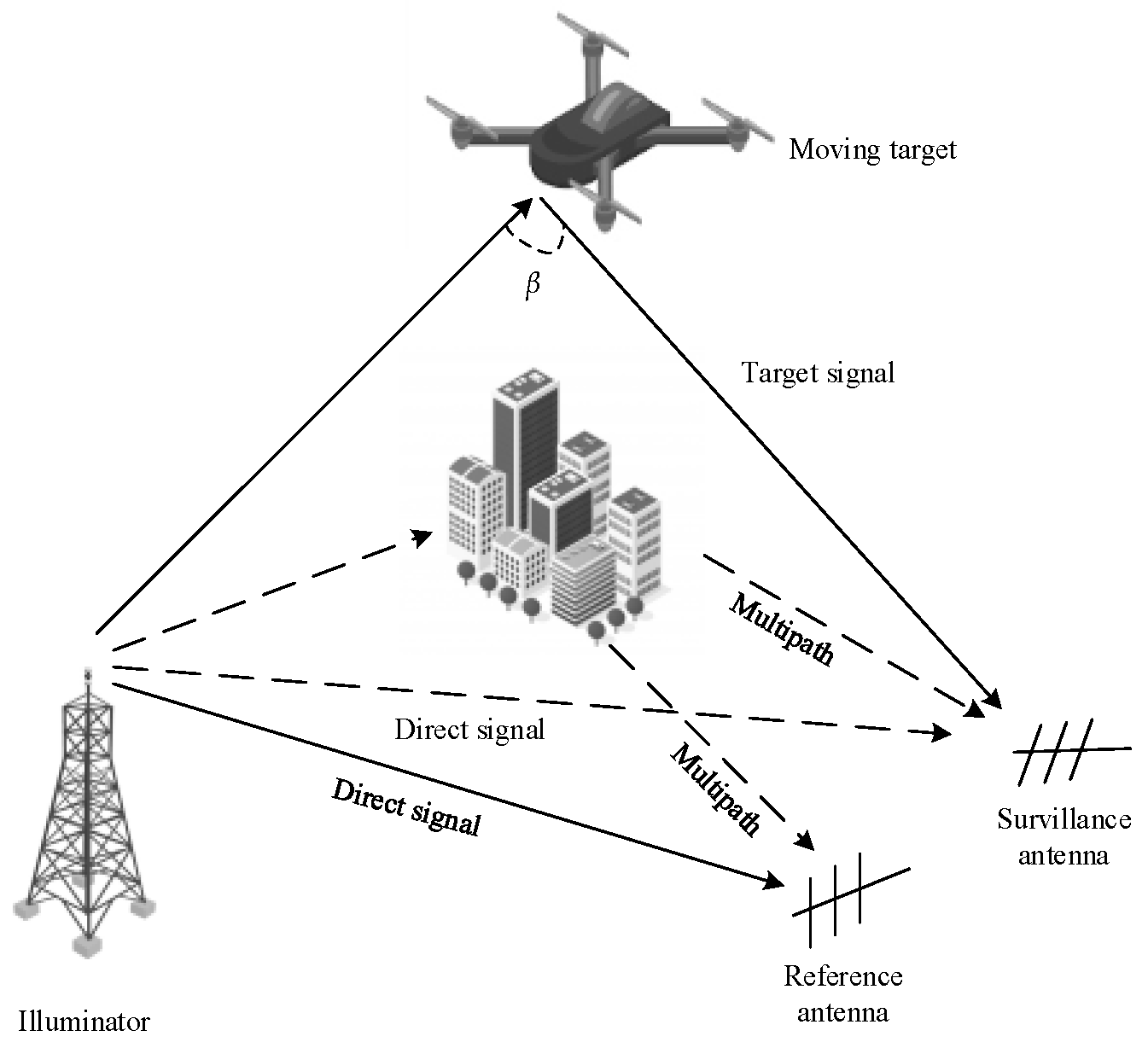

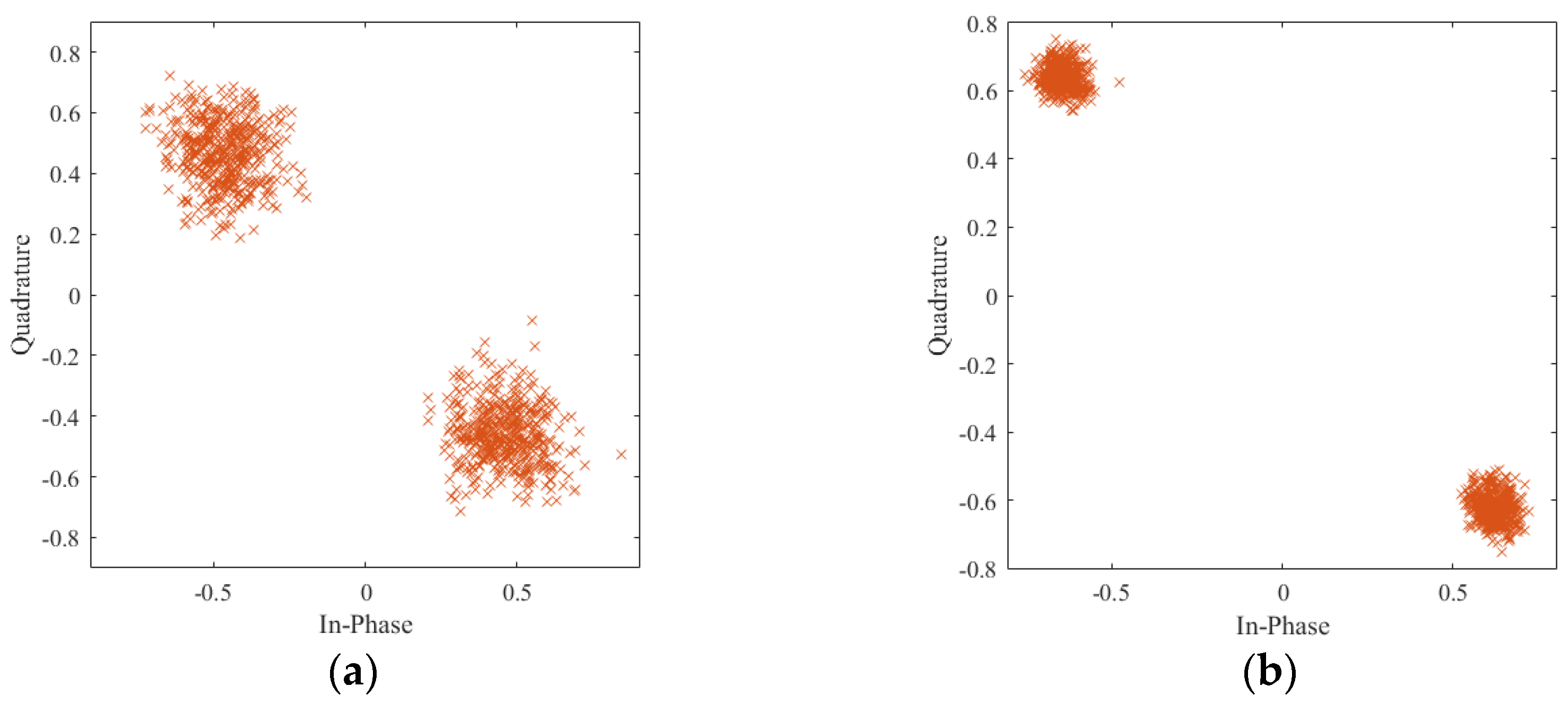
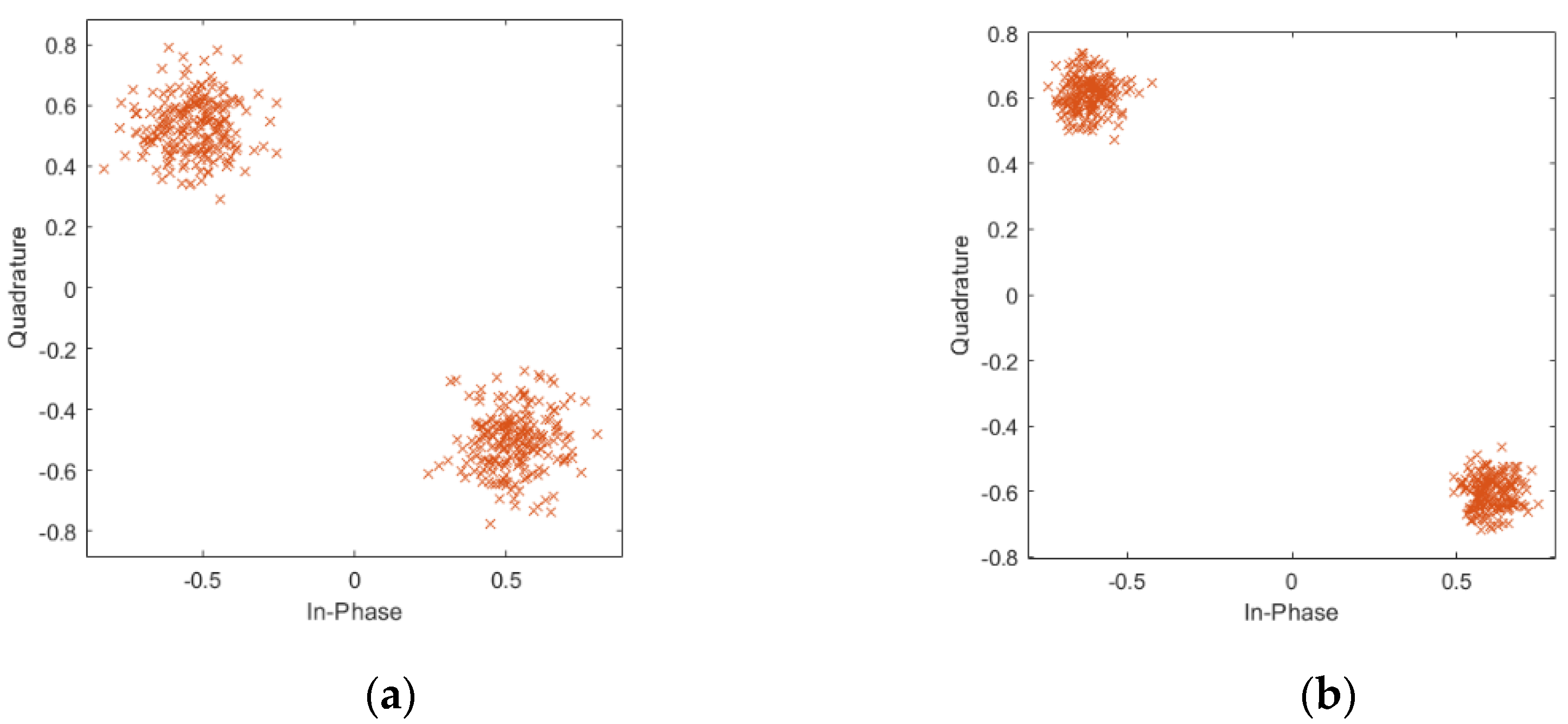
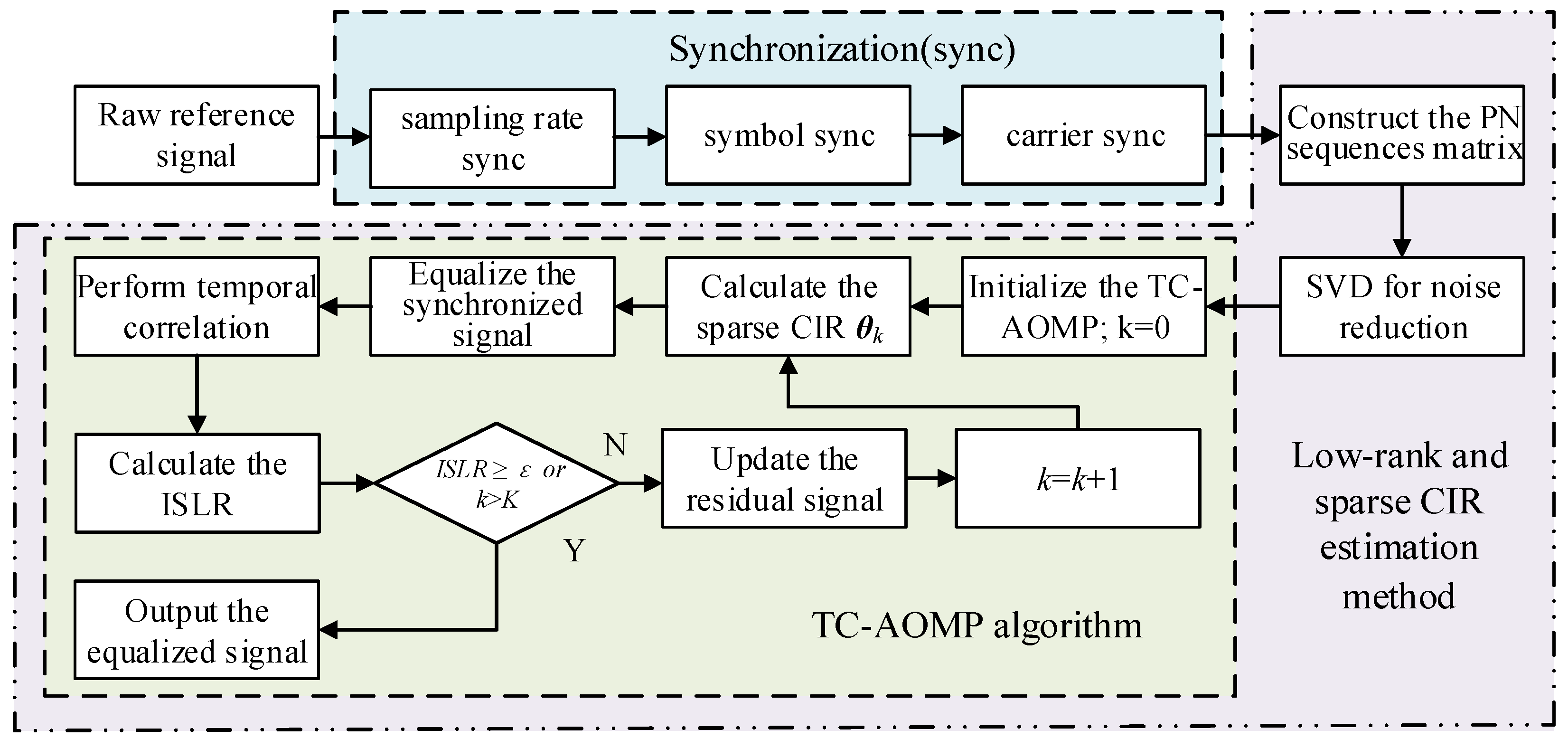



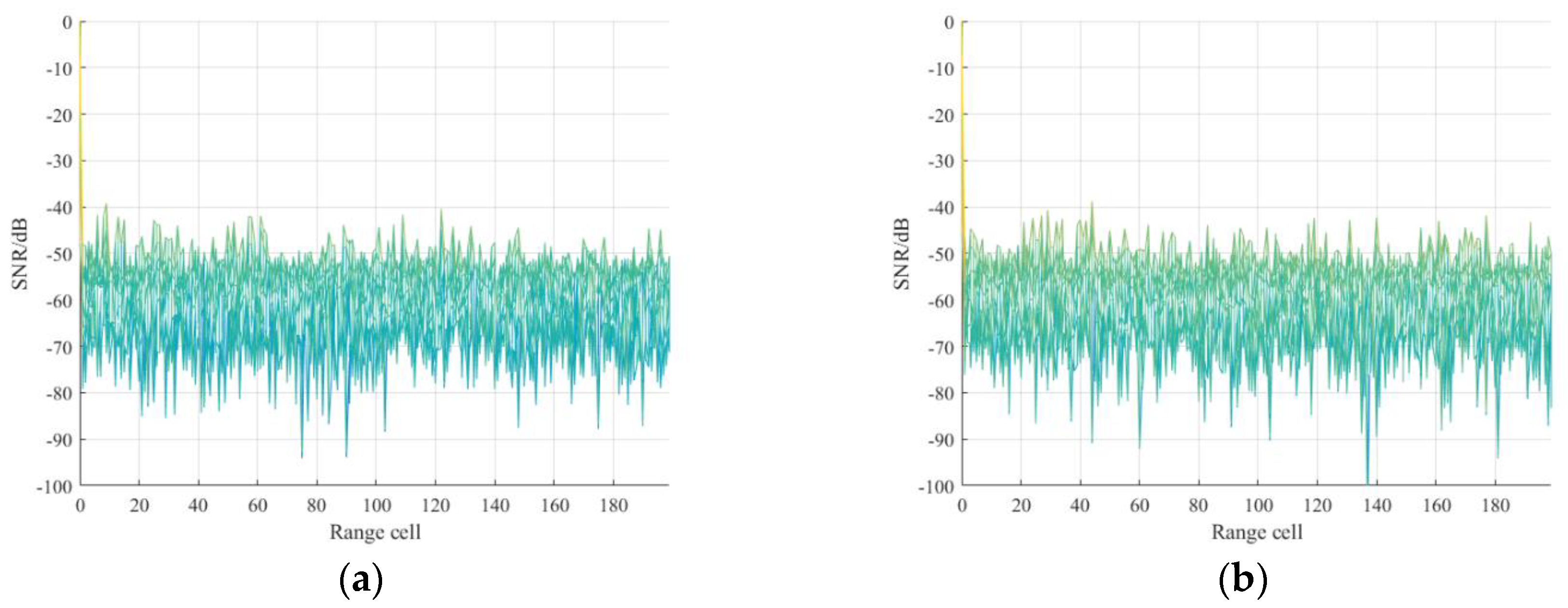

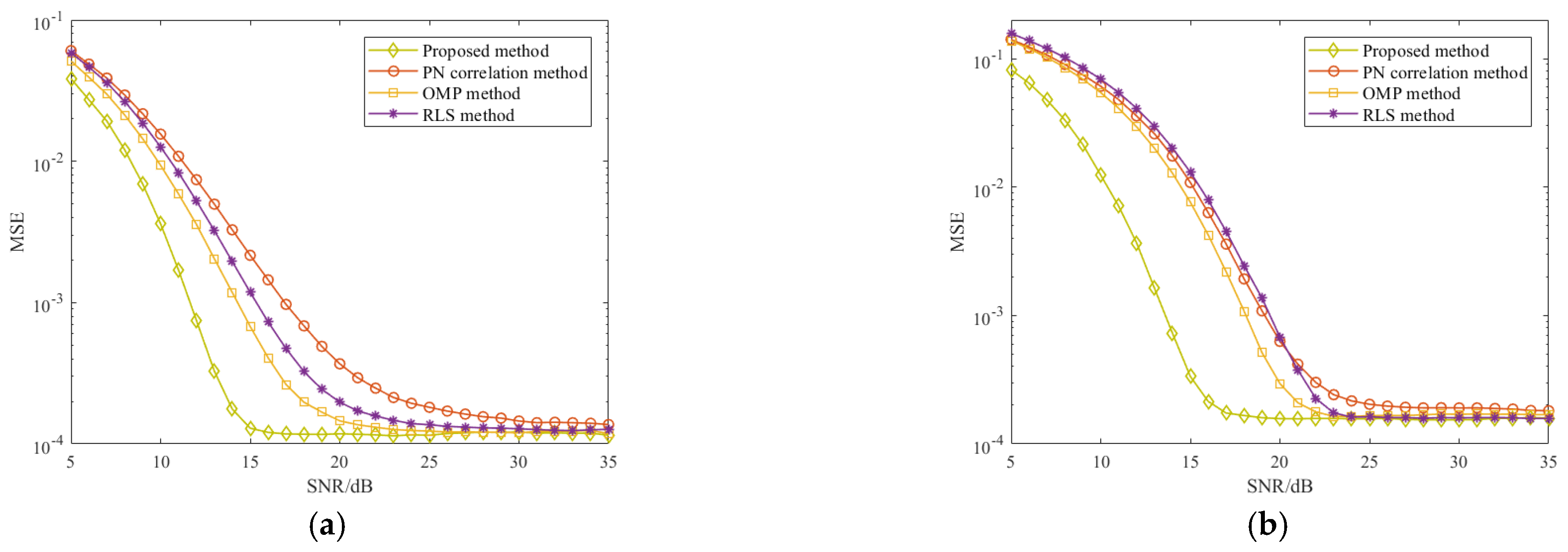
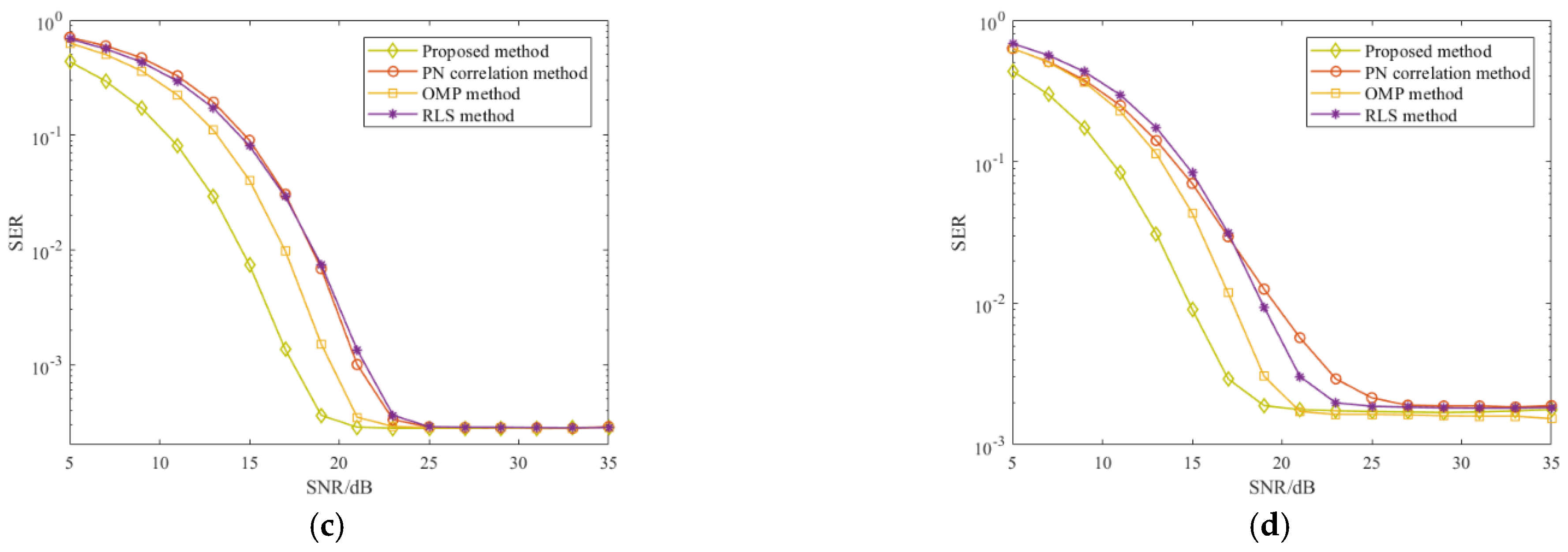
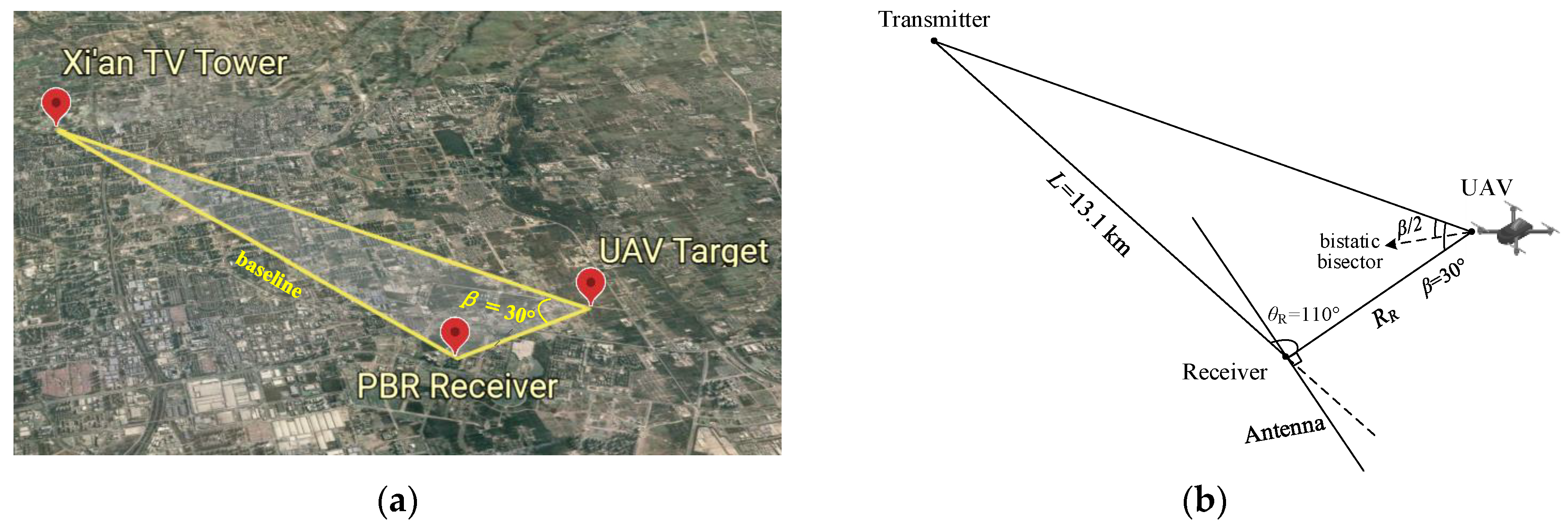
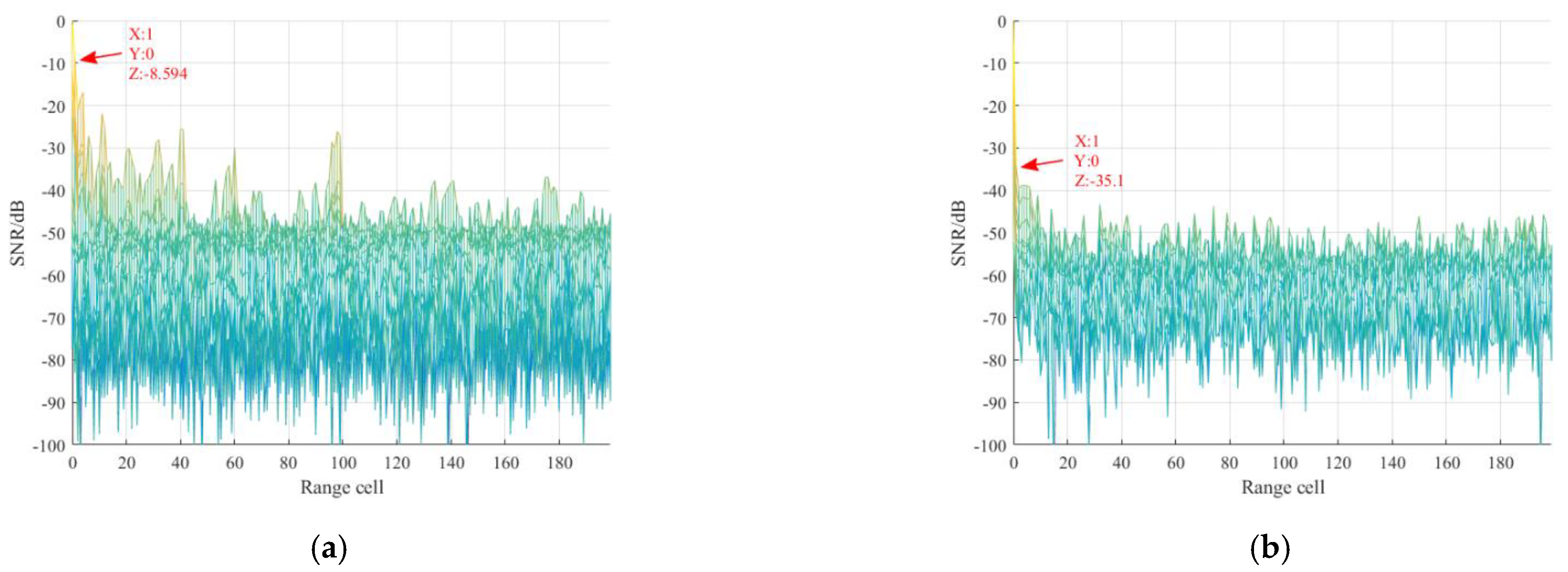
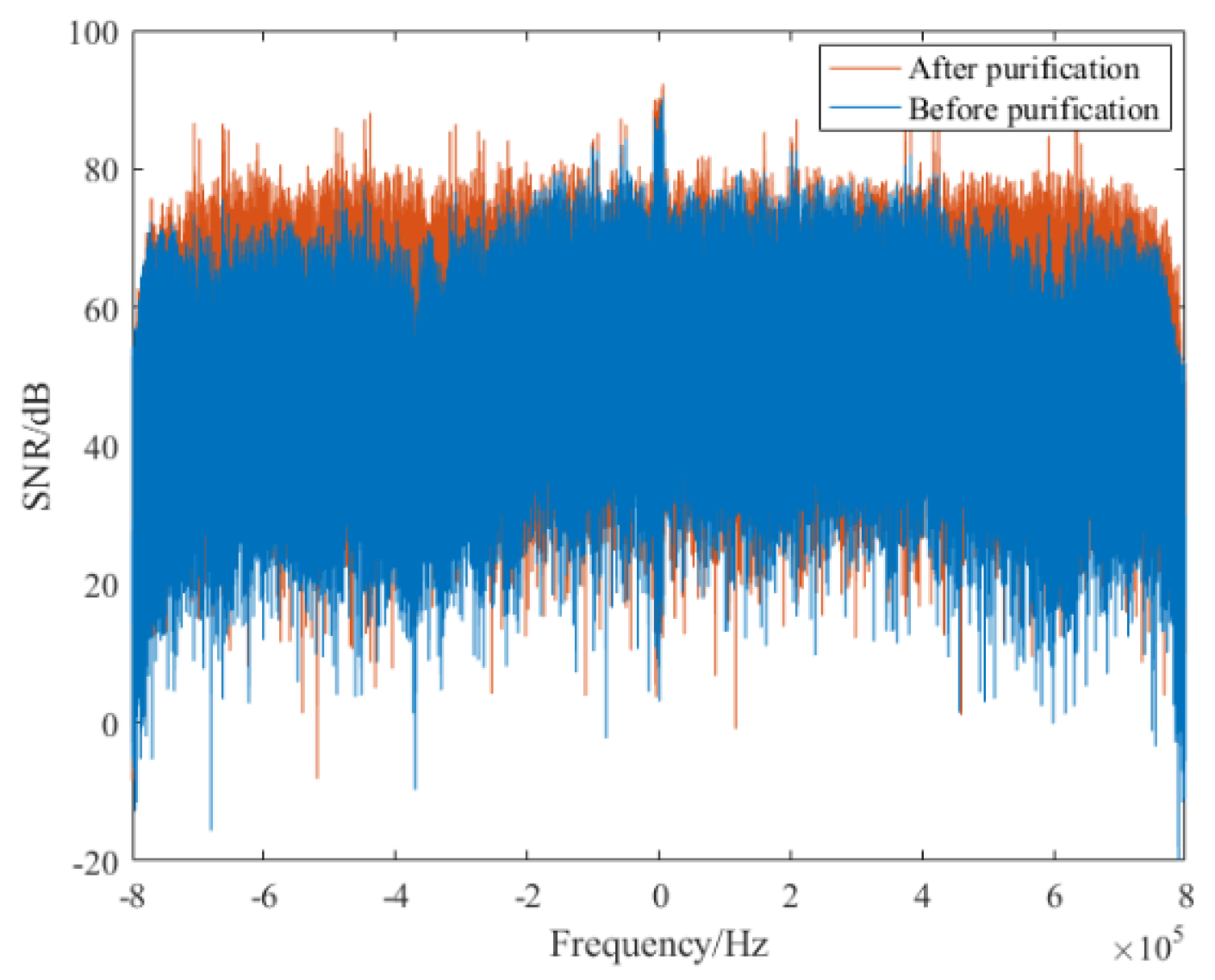
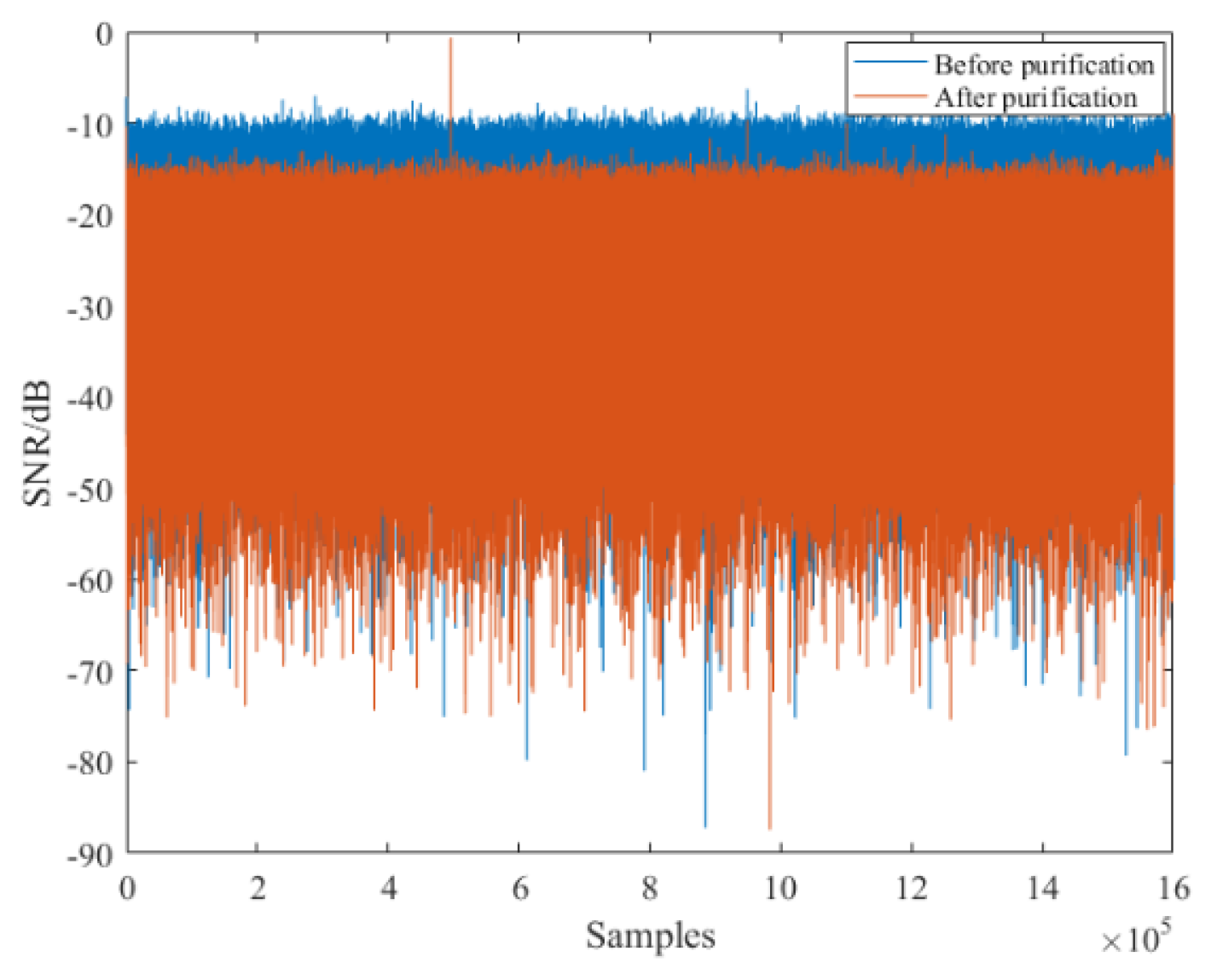
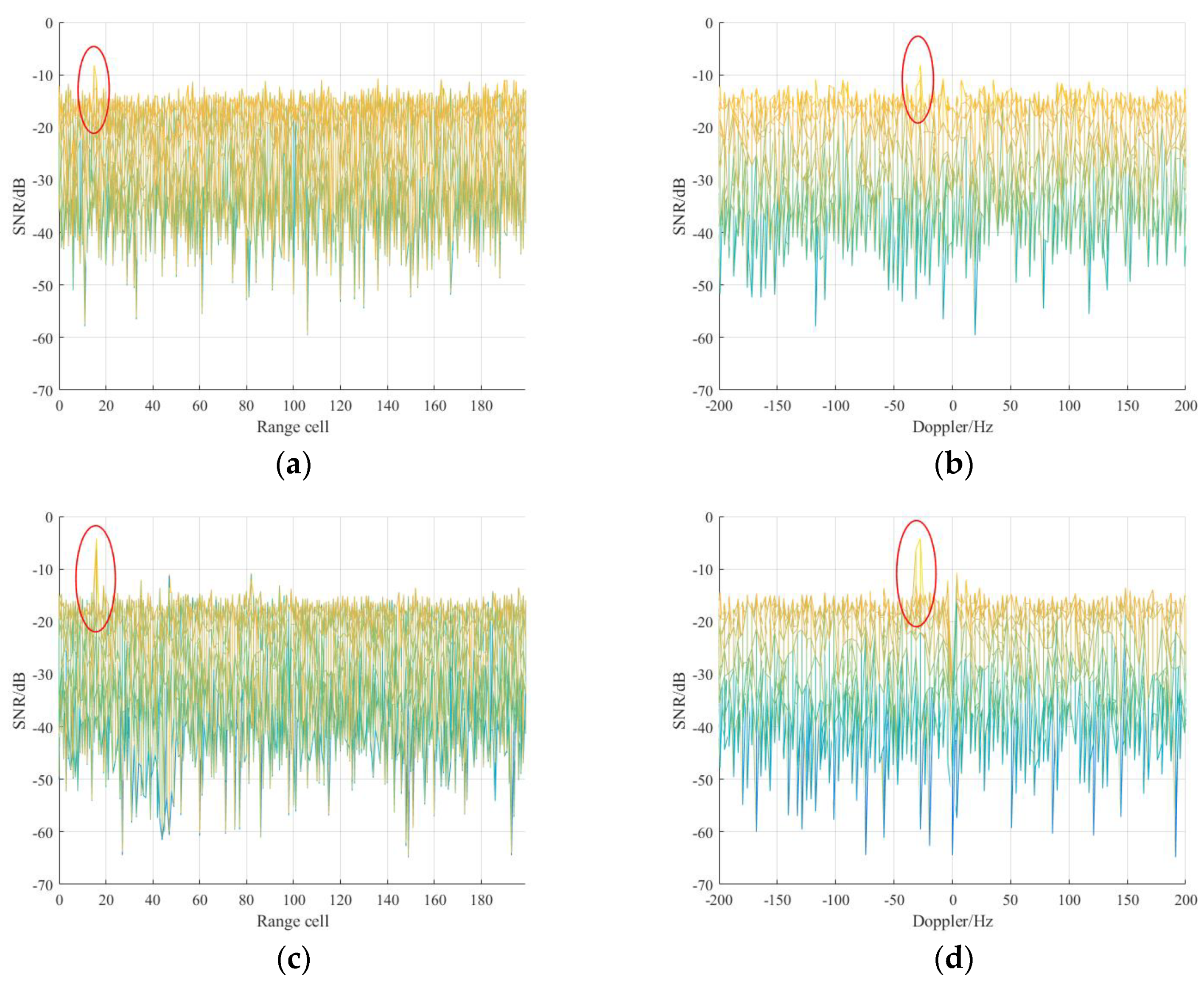
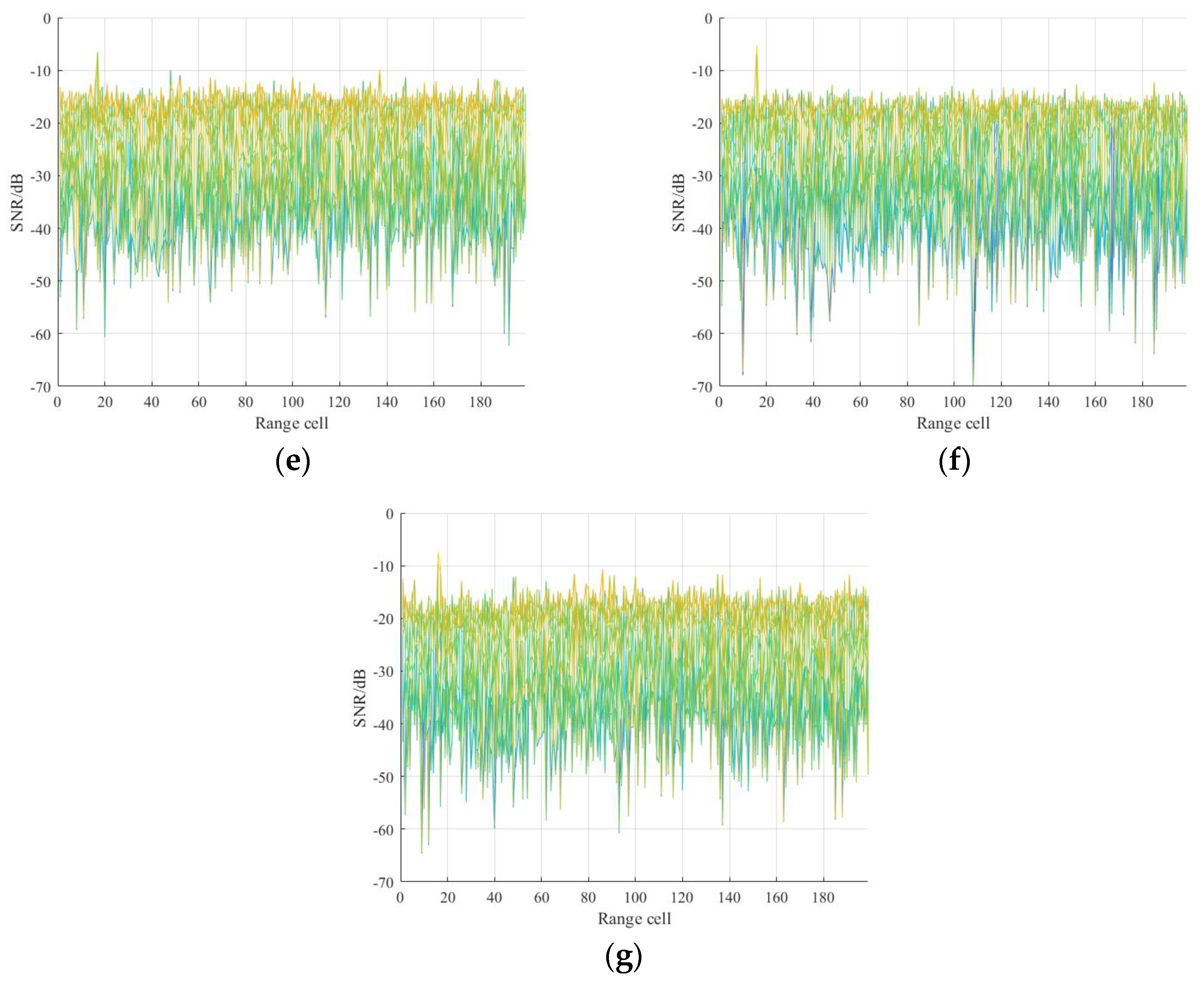
| Description | Parameter | Value |
|---|---|---|
| Total subcarriers | K | 3780 |
| Carrier frequency | fc | 666 MHz |
| Sample frequency | fs | 8 MHz |
| Bandwidth | B | 8 MHz |
| polarization mode | - | vertical |
| Power | - | 1 kW |
| Carrier spacing | ∆f | 2 kHz |
| Sample rate | 1/Ts | 7.56 MSPS |
| Signal constellation | - | 16 QAM |
| Frame header mode | - | PN420 |
| Description | Brazil A | COST207 | ||||||||||
|---|---|---|---|---|---|---|---|---|---|---|---|---|
| Tap | 1 | 2 | 3 | 4 | 5 | 6 | 1 | 2 | 3 | 4 | 5 | 6 |
| Delay (μs) | 0 | 0.15 | 2.22 | 3.05 | 5.86 | 5.93 | 0 | 0.2 | 0.6 | 1.6 | 2.4 | 5.0 |
| Power (−dB) | 0 | 13.8 | 16.2 | 14.9 | 13.6 | 16.4 | 3 | 0 | 2 | 6 | 8 | 10 |
| Method | PN Correlation | OMP | RLS | Proposed Method |
|---|---|---|---|---|
| Clutter suppression ratio | 7.8 dB | 8.7 dB | 8.1 dB | 10.6 dB |
Publisher’s Note: MDPI stays neutral with regard to jurisdictional claims in published maps and institutional affiliations. |
© 2021 by the authors. Licensee MDPI, Basel, Switzerland. This article is an open access article distributed under the terms and conditions of the Creative Commons Attribution (CC BY) license (https://creativecommons.org/licenses/by/4.0/).
Share and Cite
Zuo, L.; Wang, J.; Zhao, T.; Cheng, Z. A Joint Low-Rank and Sparse Method for Reference Signal Purification in DTMB-Based Passive Bistatic Radar. Sensors 2021, 21, 3607. https://doi.org/10.3390/s21113607
Zuo L, Wang J, Zhao T, Cheng Z. A Joint Low-Rank and Sparse Method for Reference Signal Purification in DTMB-Based Passive Bistatic Radar. Sensors. 2021; 21(11):3607. https://doi.org/10.3390/s21113607
Chicago/Turabian StyleZuo, Luo, Jun Wang, Te Zhao, and Zuhan Cheng. 2021. "A Joint Low-Rank and Sparse Method for Reference Signal Purification in DTMB-Based Passive Bistatic Radar" Sensors 21, no. 11: 3607. https://doi.org/10.3390/s21113607
APA StyleZuo, L., Wang, J., Zhao, T., & Cheng, Z. (2021). A Joint Low-Rank and Sparse Method for Reference Signal Purification in DTMB-Based Passive Bistatic Radar. Sensors, 21(11), 3607. https://doi.org/10.3390/s21113607









